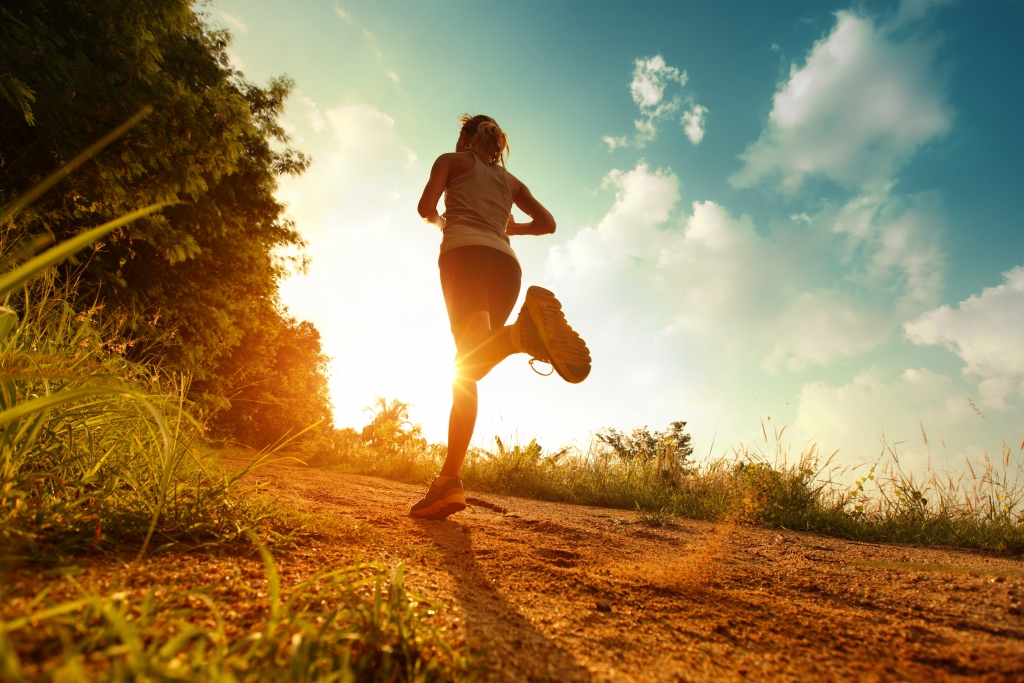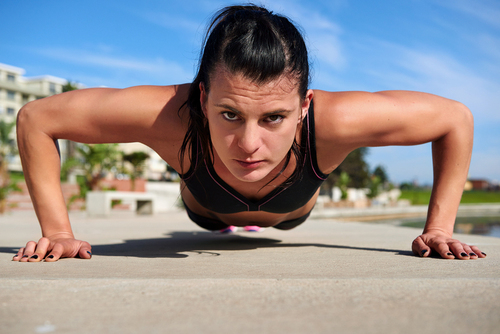How do you warm-up?

Biking off the trail is so exhilarating! But did you warm up properly so you can return to keep this feeling tomorrow too?

Nicole Lark, Personal Trainer; Breathe Fitness
The Acupuncture Turning Point collaborates with Nicole and Len, owners of Breathe Fitness, to help our clients be at their best.
Go to the Breathe Fitness website to find out more…
by Nicole Lark BHK, PTS, TSCC-3
When somebody says “I’m going to go and warm-up” at the start of a workout or before a competition or race, we often conjure up an image of someone lightly jogging on the treadmill, performing some static stretches (i.e. referred to as the ‘general warm-up’ portion), and then possibly incorporating some more sport-specific movements (i.e. referred to as the ‘specific warm-up’ portion) for example, dribbling, passing, and kicking the soccer ball before a soccer game.
Historically, we have been told that warming up will reduce our risk of injury and help improve performance. While the evidence supporting the idea that warming up will reduce the risk of injury is actually unclear, what is clear is that a well-structured warm-up can confer a number of physiological responses that can potentially increase performance by helping to prepare physically and mentally for the upcoming challenges.
At the physiological level, a sound warm-up should gradually elevate body temperature, heart rate, respiration rate, blood flow and improve joint fluid viscosity. Mentally, the warm-up should prepare the client or athlete for the upcoming demands of the activity (e.g. for a heavy-lift on a training day or the demands of the particular sport on a competition day).
Typically, a warm-up should last somewhere between 10 and 20 minutes. This provides enough time to gradually incorporate sufficient intensity to increase the body’s core temperature without causing fatigue for the upcoming demands of the training session or competition (Haff and Triplett, 2016).
An Improved Formula for Warm-Ups

Trail running is bliss; but have you warmed up properly so you will do it again tomorrow?
The acronym, RAMP, which stands for Raise, Activate and Mobilize, and Potentiate is a protocol many trainers and coaches are now implementing within their programs. RAMP, developed by Ian Jeffreys, is different compared to the more traditional warm-up (i.e. general warm-up and specific warm-up periods). It is much more specific to the upcoming demands and it can be strategically implemented to help develop the athlete or client over the long-term. By incorporating different movement patterns, movement skills, and a variety of dynamic and biomechanically varied exercises into every warm-up, the athlete or client, will be contributing over time to the gradual improvement of their overall athletic development through greater cumulative training loads.
Raise
The purpose is to elevate the heart rate, body temperature, respiration rate, blood flow and joint fluid viscosity with low-intensity aerobic activity. In a general warm-up, a person would hop on the bike or treadmill or go for a light jog outdoors before their workout or sporting activity. The RAMP protocol differs because it makes this component more specific by incorporating movement patterns or skill patterns that simulate the demands of the athlete’s sport, or the client’s upcoming workout. For example, a soccer player may perform skipping, lateral shuffles, high knees, butt kickers and bounds in preparation for a practice or game. This protocol also helps with psychological preparation as there is a direct transfer of the components being used in warm-up and those that will be required for the workout or competition.
Activating and Mobilizing
The second part of a typical warm-up is stretching; however, the RAMP protocol instead incorporates key movement patterns such as lunging and squatting movements that develop mobility, motor control, stability, and flexibility. Dynamic movement patterns such as squats and lunges not only prepare the client or athlete for the upcoming session but they also have a long-term development aspect of helping to build the persons overall base of athleticism and movement capacities. In addition, dynamic stretching and mobility exercises are very time-efficient. Each movement pattern often incorporates multiple joints in multiple planes therefore hitting more muscles, joints, and movement capacities in less time – something many clients and athletes need more of!
Potentiation

Reaching your workout goals today is important! But did you warm up properly so you can reach them tomorrow as well?
The last phase is where sport-specific activities of increasing intensity are incorporated. This is the portion of the warm-up that will see a gradual shift towards the actual sport performance or workout itself.
Physiologically, the potentiation phase has two main aims:
- Increase the intensity of exercise to the level required for the activity/competition/session. If maximal exertion is required then some of the activities should be performed at maximal levels (the more power required for the upcoming sport or activity, the greater importance this phase of warm-up has!).
- Utilization of the post-activation potentiation (PAP) effect. In layman’s terms, this means that the muscles which have been voluntarily activated (i.e. post-activation) are able to produce more force for a period of time afterwards (i.e. potentiated).
For example, if the workout is geared towards developing sprinting speed, sprint drills of increasing intensity would be used. Or, if a client or athlete is warming-up for a power-based gym workout, plyometrics, medicine ball, and lighter explosive resistance exercises could be incorporated. This will allow the client or athlete to seamlessly progress into exerting maximal effort for the first set and to better target the intended training stimulus; thus, improving the overall effectiveness of the training session. Or, if the athlete is warming-up to compete, to help the athlete achieve peak performance right from the start of the competition (Jeffreys, 2007).
Another important aspect of the RAMP warm-up protocol is the concept of being able to continually ‘micro-dose’ elements of a sport that are important for athlete or client success. For example, speed, agility, and power are often important components in a training program; however, it is often difficult to find adequate training time to maximize potential. If an athlete can incorporate small amounts of agility, speed, or power training into the warm-up, they are not only better preparing themselves for the upcoming workout or competition, but also adding in valuable volume to their overall training load, and adding it in at the optimal time of a workout (i.e. before fatigue sets in). Therefore, the purpose of the potentiation phase has the short-term benefit of preparing the athlete or client for that day and the long-term training benefit of maximizing the overall capacity of the athlete or client.
Take Home Message
The warm-up should be considered an integral component prior to a workout or competition. The RAMP protocol provides a sound framework for ensuring the client or athlete is prepared for maximum performance via raising, activation and mobilization, and potentiation without any level of fatigue. When planning the warm-up, the trainer or coach should select exercises to maximize its short-term effectiveness but also understand how to use the warm-up to aid in the long-term development of the athlete or client.
References
Haff, G., and Triplett, T. (2016). Essentials of Strength Training and Conditioning, Fourth Edition. Champaign: Human Kinetics.
Jeffreys I (2007) Warm-up revisited: The ramp method of optimizing warm-ups. Professional Strength and Conditioning. (6) 12-18.




